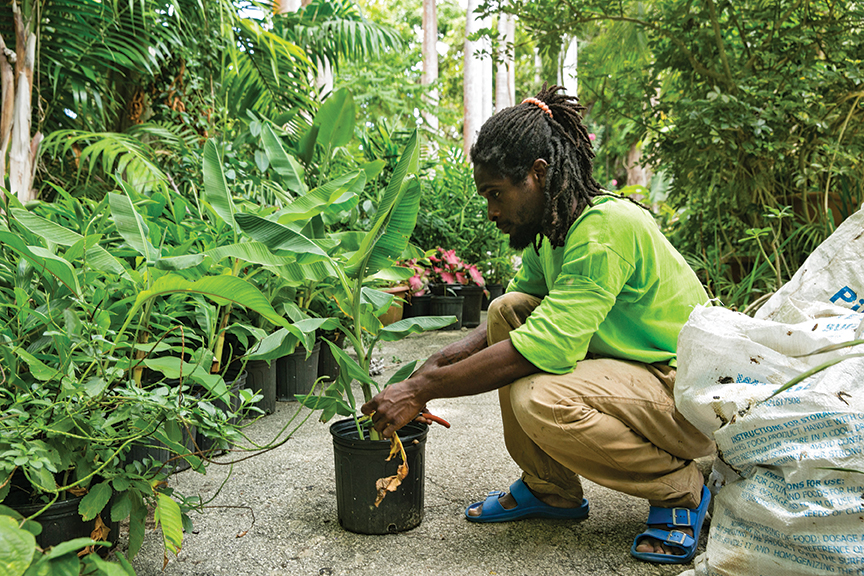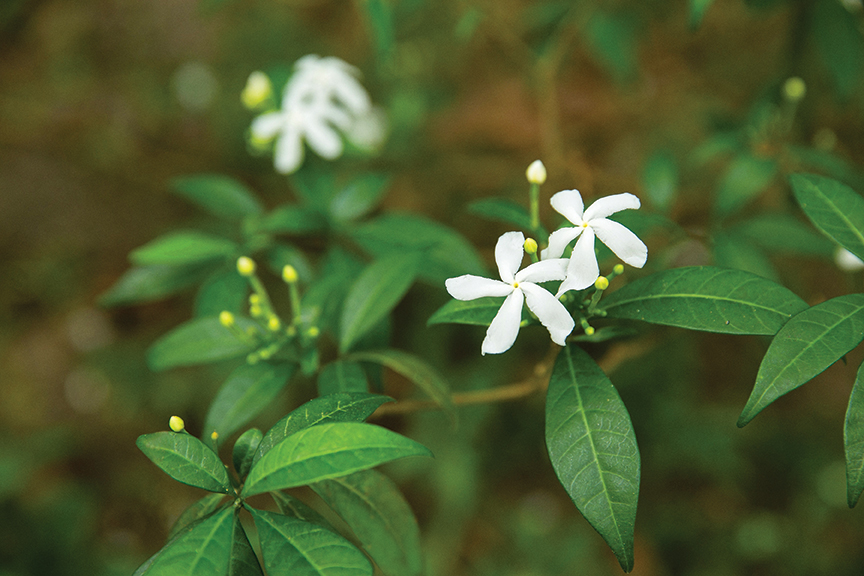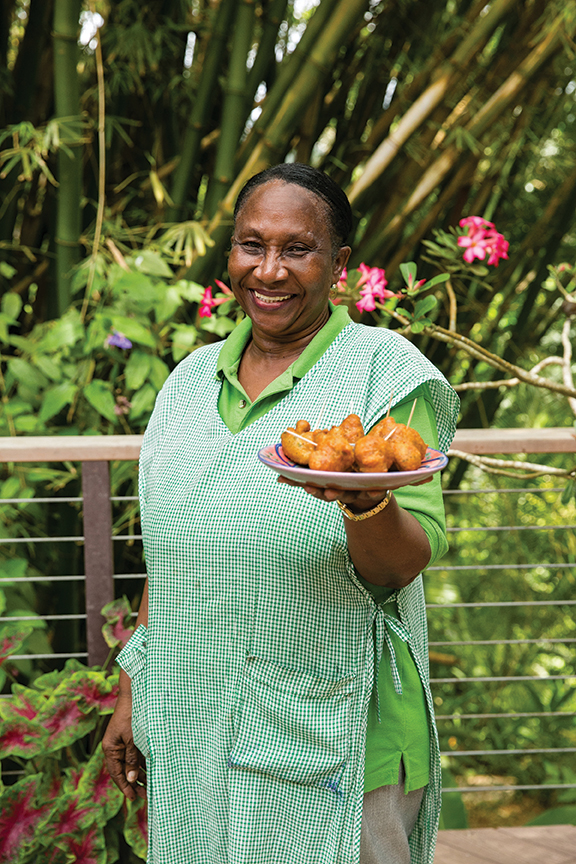The Pride of Barbados: Peace & Perfume in the Flower Forest
Vanilla-scented blue durantas, aromatic bay leaves and ylang-ylang (better known as Chanel no. 5) waft along the pathways of the Flower Forest.
— By Amie Watson
— Photography: Kenneth Theysen
David Spieler
Owner – Flower Forest
The more than 53 acres of botanical gardens are located on a former sugar plantation in the lush, clay-soiled Scotland District of Barbados. When the island was born, hundreds of thousands of years ago, this clay area rose out of the ocean and the coral on top slipped down into the sea, creating mushroom-like rocks on the East Coast and coral steps on the south, west and north, but leaving rolling, grassy hills and gullies reminiscent of Scotland, in the middle.
Flower Forest is the biggest garden in Barbados and is protected as part of the country’s national park system, says soft-spoken owner David Spieler, a trained biologist who bought the property nine years ago. He came to the island from Canada with his mom, an artist, in 1966 and worked for thirty years with her at Earthworks Pottery. But when the opportunity came to buy the garden, he took it. “I realised how peaceful it made me feel and how everyone suffers from stress and the fast pace of life. I wanted to help people get back their peace and tranquillity. That’s what Flower Forest is: you get there and everything is good.”
Walking through the winding paths, the world slows down, and it’s hard not to breathe a little deeper. The garden is designed to draw the eye; from a pomerac tree, which drops strands of neon pink vermicelli petals on top of giant green shell ginger leaves, your gaze moves to fire plug curcuma flaviflora, a relative of turmeric used to promote longevity and reduce arthritis. Nearby, rattlesnake flowers resembling long, narrow yellow corncobs lead to fire spikes (bright red petals that look like Q-Tips) and tightly wound pink and white honeycombs that lure your eyes up the trunk of a traveller’s palm. Dotting the entire 3D floral canvas are right red heliconias, whose yellow-and-green-tipped offset petals resemble macaws’ bills.
Next to an aromatic Rangoon creeper dangle hundreds of hanging roots of a bearded fig tree. “It’s actually a giant colony of roots”, says Spieler. The branches come down and develop into another trunk, he explains, which is how the island got its name. “Los Barbados – the bearded ones”, he says. “They’ll tell you a story about seeing bearded men upon the beach, but the original inhabitants of the Caribbean were the Amerindians from South America. No beards. This tree is the bearded one.”
“Have you eaten annatto before?” he asks. Caribbean annatto is rare in Barbados, Spieler says, taking a pod off a stem and opening it to reveal about twenty bright red edible seeds the size of pebbles. “This was spread throughout the Caribbean by the Amerindians from South America and prized as antibacterial.” Used for lipstick, body paint and cooking, they’re juicy, soft, sweet and a little bitter – unlike the rock-hard dried annatto you’ll find in spice shops.
At Liv’s Lookout, the sweet smell of henna accompanies the stunning view of green palms in the gully below. While at the intimate gazebo, a popular wedding location, Spieler points out the double swirl design of the ground. “It starts from without and joins in the middle”, he says. He married friends here a few months ago. “They didn’t want a big wedding. It was the bride and groom, the preacher, me, a cake and a bottle of Champagne. I didn’t realise I was going to be the witness and photographer! And it was awesome.”
It’s hard to think that this majestic property might no longer be in operation were it not for Spieler. He sat on the Flower Forest’s board with founder Don Hill, who passed away a few years ago. When the board realised that the road to the Flower Forest was slipping away, they pretty much gave up, he says. “They basically wanted to get rid of it because people wouldn’t be able to get here.”
But Spieler knew the value of the garden, which was designed by Richard Coghlan, a horticulturalist trained at Kew Gardens in England – the world’s largest collection of living plants. So he bought the property and added a café, which serves some of the best fishcakes in Barbados along with fried flying fish cutter sandwiches, breadfruit French fries, fresh limeade with limes from a farm in nearby Mount Wilton and organic teas made with lemongrass, bay leaves and other herbs fresh from the garden.
But he could have opened a Michelin-starred restaurant and still been in trouble without a road. “The landslide would keep eating away like a shark coming toward us and taking chunks out of the hillside as it slid down the road. I bought a worthless place and everybody asked me if I’d taken leave of my senses.” To slow the slippage, Spieler and his team had to replace the stone baskets on the hillside and build drainpipes under the soil.
Their efforts staunched the wound, and over the first seven years, the business blossomed. “So in the eighth year we took all of the money that we made and invested it in fixing the road. Now the Flower Forest is an accessible and therefore desirable garden. And everyone says what a beautiful place it is. It’s been nine years of hard work and now the sky’s the limit.”
Now he and his team of four gardeners can concentrate on sculpting the garden. Shane and Dennis, the garden’s flower whisperer (“he can do anything with a plant”, says Spieler), are transplanting ferns near the white durantas, which have a more subtle vanilla scent than the blues. The one thing Dennis can’t do is keep the monkeys away from the Indian golden apples. The primates seem to leave the breadfruit alone, however, which Spieler appreciates. “I like to pickle the breadfruit with lime, cucumbers and parsley”, he says. “You can also boil or fry them like we do at the café, or mash them into a purée and eat them with stew.”
Though it’s become a Bajan staple, the history of breadfruit on the island goes back to the “Mutiny on the Bounty” and the British captain William Bligh, who in 1787 sailed from England to Tahiti and then on to the Caribbean with Tahitian breadfruit plants. “But he was watering his plants on the way and not watering his crew very well”, says Spieler. So after some of his crew mutinied, they set him adrift and tossed his precious breadfruit into the sea. Undeterred, Bligh eventually made it back to England and successfully brought breadfruit on a second voyage several years later.
Almost at the end of the garden, Spieler points out a flowering red Pride of Barbados tree, which can be seen along roads throughout the country. Rather than explaining the history of the plant, however, he simply marvels at its branches draping elegantly from above the garden path.
“I like to let the garden speak for itself”, he says, which it does. It’s the sum of its flowers – native and exotic blossoms, trees and ferns – on a carefully planned annual clock. There might not be breadfruit in February, but there will be blue flowering jade and winter honeycombs. Each month brings a new experience, a new colour and a new perspective, giving visitors a reason to return again and again.
Exiting the garden, you realise that the true pride of Barbados is more than a single plant – it’s a garden.









